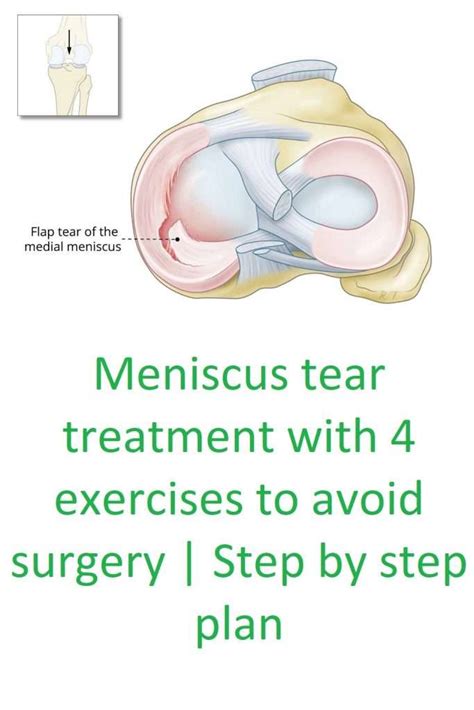Intro
Torn meniscus treatment options include surgery, physical therapy, and pain management, offering relief from knee pain and inflammation, promoting healing and recovery for meniscus tear sufferers.
A torn meniscus is a common injury that can cause significant pain and discomfort in the knee joint. The meniscus is a piece of cartilage that cushions the joint between the bones of the leg, and when it becomes torn, it can lead to a range of symptoms, including swelling, stiffness, and limited mobility. If you're experiencing these symptoms, it's essential to seek medical attention to determine the best course of treatment. In this article, we'll explore the various treatment options available for a torn meniscus, including conservative management, surgical interventions, and rehabilitation techniques.
The importance of seeking medical attention for a torn meniscus cannot be overstated. If left untreated, the injury can lead to further complications, such as arthritis, chronic pain, and reduced mobility. Moreover, a torn meniscus can significantly impact daily activities, making it challenging to perform even simple tasks. Fortunately, with the right treatment, it's possible to alleviate symptoms, promote healing, and restore knee function. Whether you're an athlete or an individual with a busy lifestyle, understanding the treatment options available can help you make informed decisions about your care.
The diagnosis of a torn meniscus typically involves a combination of physical examination, medical history, and imaging tests, such as X-rays or MRI scans. Once the diagnosis is confirmed, your healthcare provider will discuss the treatment options with you, taking into account the severity of the injury, your overall health, and your lifestyle. Treatment for a torn meniscus can range from conservative management, such as physical therapy and pain management, to surgical interventions, such as arthroscopy or open surgery. In some cases, a combination of both conservative and surgical approaches may be necessary to achieve optimal results.
Treatment Options for a Torn Meniscus

The primary goal of treatment for a torn meniscus is to alleviate symptoms, promote healing, and restore knee function. The treatment options can be broadly categorized into conservative management, surgical interventions, and rehabilitation techniques. Conservative management involves non-surgical approaches, such as physical therapy, pain management, and lifestyle modifications. Surgical interventions, on the other hand, involve procedures that repair or remove the damaged meniscus tissue. Rehabilitation techniques, including exercises and physical therapy, play a crucial role in promoting healing and restoring knee function.
Conservative Management
Conservative management is often the first line of treatment for a torn meniscus, especially for minor tears. This approach involves a combination of physical therapy, pain management, and lifestyle modifications. Physical therapy can help improve knee mobility, strengthen the surrounding muscles, and promote healing. Pain management may involve the use of medications, such as non-steroidal anti-inflammatory drugs (NSAIDs) or corticosteroid injections, to alleviate pain and inflammation. Lifestyle modifications, such as avoiding heavy lifting, bending, or twisting, can help reduce stress on the knee joint and promote healing.Surgical Interventions

Surgical interventions may be necessary for more severe tears or when conservative management is ineffective. The primary surgical options for a torn meniscus include arthroscopy, open surgery, and meniscectomy. Arthroscopy involves the use of a small camera and surgical instruments to repair or remove the damaged meniscus tissue. Open surgery, on the other hand, involves a larger incision to access the knee joint. Meniscectomy involves the removal of the damaged meniscus tissue, which can provide relief from symptoms but may increase the risk of arthritis in the long term.
Rehabilitation Techniques
Rehabilitation techniques play a crucial role in promoting healing and restoring knee function after a torn meniscus. The primary rehabilitation techniques include exercises, physical therapy, and bracing. Exercises can help improve knee mobility, strengthen the surrounding muscles, and promote healing. Physical therapy can help improve knee function, reduce pain and inflammation, and promote overall well-being. Bracing, such as the use of a knee sleeve or orthotics, can provide additional support and stability to the knee joint.Benefits and Risks of Treatment Options

Each treatment option for a torn meniscus has its benefits and risks. Conservative management, for example, is often less invasive and less expensive than surgical interventions but may not provide relief from symptoms for more severe tears. Surgical interventions, on the other hand, can provide relief from symptoms but carry risks, such as infection, bleeding, and nerve damage. Rehabilitation techniques, including exercises and physical therapy, can promote healing and restore knee function but may require a significant investment of time and effort.
Practical Examples and Statistical Data
Practical examples and statistical data can help illustrate the effectiveness of treatment options for a torn meniscus. For example, a study published in the Journal of Orthopaedic and Sports Physical Therapy found that conservative management was effective in reducing symptoms and improving knee function in patients with minor meniscus tears. Another study published in the American Journal of Sports Medicine found that arthroscopic surgery was effective in reducing symptoms and improving knee function in patients with more severe meniscus tears. Statistical data, such as the success rates of treatment options and the risk of complications, can also help inform treatment decisions.Conclusion and Next Steps

In conclusion, treatment for a torn meniscus depends on the severity of the injury, overall health, and lifestyle. Conservative management, surgical interventions, and rehabilitation techniques can all play a role in promoting healing and restoring knee function. By understanding the benefits and risks of each treatment option, individuals can make informed decisions about their care. If you're experiencing symptoms of a torn meniscus, it's essential to seek medical attention to determine the best course of treatment. With the right treatment and rehabilitation, it's possible to alleviate symptoms, promote healing, and restore knee function.
Final Thoughts and Recommendations
In final thoughts, treatment for a torn meniscus requires a comprehensive approach that takes into account the severity of the injury, overall health, and lifestyle. By combining conservative management, surgical interventions, and rehabilitation techniques, individuals can promote healing and restore knee function. Recommendations for treatment may vary depending on the individual case, but a thorough evaluation and diagnosis are essential to determining the best course of treatment.What are the symptoms of a torn meniscus?
+The symptoms of a torn meniscus can include pain, swelling, stiffness, and limited mobility in the knee joint.
What are the treatment options for a torn meniscus?
+The treatment options for a torn meniscus can include conservative management, surgical interventions, and rehabilitation techniques.
How long does it take to recover from a torn meniscus?
+The recovery time for a torn meniscus can vary depending on the severity of the injury and the treatment approach, but it can take several weeks to several months to fully recover.
We invite you to share your thoughts and experiences with torn meniscus treatment in the comments below. If you found this article helpful, please share it with others who may be experiencing similar symptoms. By working together, we can promote awareness and understanding of torn meniscus treatment options and help individuals make informed decisions about their care.
